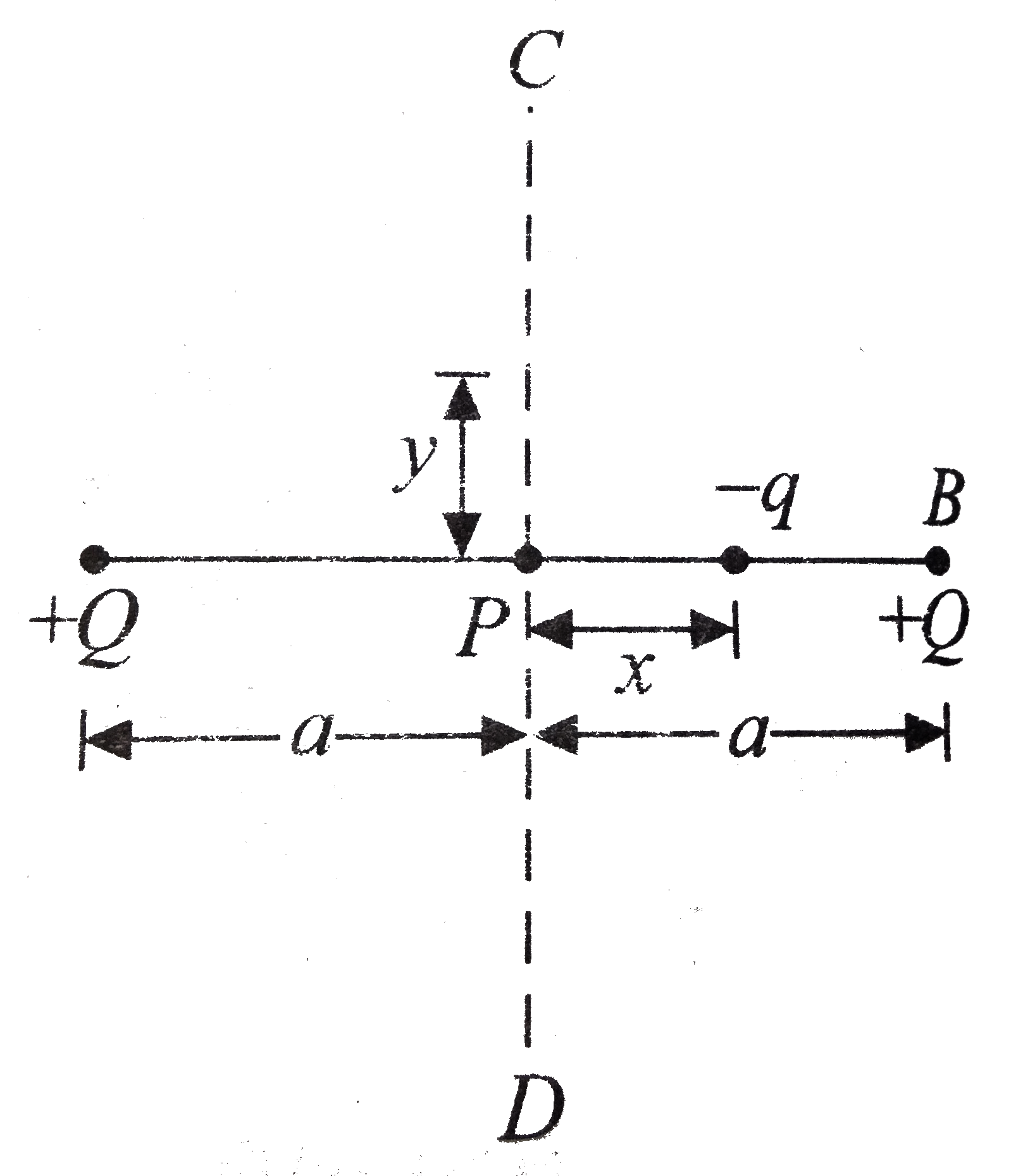A unit negative charge with mass resides at the midpoint of the straight line of length 2a adjoining two fixed charges of magnitude +Q each. If it is given a very small displacement x(x<<a) in a direction perpendicular to the straight line, it will Solution in Bengali
come back to its original position and stay there
excute oscillations with freqeuncy 12π√Q4πε0Ma3
fly to infinity
execute oscillations with frequency 12π√Q2πε0Ma3
Fnet=−2Fcosθ=−2KQ×1(x2+a2)×x√x2+a2
=−2kQ(x2+a2)32x
∴Fnet≈−(2KQa3)x[∴x<<a]

Frequency of oscillation
12π√2kQMa3=12π
⎷2×14πε0QMa3=12π√Q2πε0Ma3
[frequency of SHM. n=12π√accelerationdisplacement]
Topper's Solved these Questions
- BOOK - CHHAYA PUBLICATIONCHAPTER - ELECTRIC FIELDEXERCISE - EXAMINATION ARCHIVE ( JEE MAIN )3videos
ELECTRIC FIELD
- BOOK - CHHAYA PUBLICATIONCHAPTER - ELECTRIC FIELDEXERCISE - EXAMINATION ARCHIVE ( AIPMT)1videos
ELECTRIC FIELD
- BOOK - CHHAYA PUBLICATIONCHAPTER - ELECTRIC FIELDEXERCISE - EXAMINATION ARCHIVE (WBCHSE)13videos
ELECTRIC FIELD
- BOOK - CHHAYA PUBLICATIONCHAPTER - ELECTRIC ENERGY AND POWEREXERCISE - CBSE SCANNER7videos
ELECTRIC ENERGY AND POWER
- BOOK - CHHAYA PUBLICATIONCHAPTER - ELECTRIC POTENTIAL EXERCISE - CBSE Scanner13videos
ELECTRIC POTENTIAL
Similar Questions
A long cylindrical shell carries positive surface charge σ in the upper half and negative surface charge −σ in the lower half. The electric field lines around the cylinder will look like figure given in (figures are schematic and not drawn to scale)
02:33View SolutionThe eletric field in a certina region is acting radially outward and is given by E = Ar. A charge contained in 'a' centred at the origin of the field will be givne by
05:43View SolutionFour point charges +q,+q,+q and −q are placed at the four comers of a square, length of each side of which is a.
Find the magnitude of the intensity of the electric field at the centre of the square.04:33View SolutionA light bulb is rated 100 W for 220 V ac supply of 50 Hz. Calculate
the resistance of the bulb ,04:20View SolutionA test charge q is moved without acceleration along the path from A to B from B to C in electric field E as shown in fig.

(i) Calculate the potential difference between A and C.08:17View SolutionTwo negative charges of a unit magnitude and a positive charge q are placed along a straight line. At what position and value of q will the system be in equilibrium? (Negative charges are fixed).
06:38View SolutionIn the arrangement shown in fig. two positive charges, +Q each,are fixed. Mark the correct statement(s) regarding a third charged particle q palce at the midpoint P that can be displaced along or perpendicular to the line connecting the charges.
 09:00View Solution
09:00View SolutionTwo identical charges +Q are kept fixed some distance apart.A small particles P with charge q is placed midway between them . If P is given a small displacement Delta ,it will undergo simple harmonic motion if (i) q is positive and Delta is along the line joining the charges (ii) q is positive and Delta is perpendicular to the line joining the charges (iii) q is negative and Delta is perpendicular to the line joining the charges (iv) q is positive and Delta is along the line joining the charges
05:15View SolutionTwo negative point charges each of magnitude 2 esu and another point charge q are lying on a straight line. Each of the charges are in equilibrium. Determine the position, value and the nature of the charge q.
View SolutionTwo negative charges each of 1 unit and a positive charge q are placed along a straight line. Find the magnitude and position of q for which all the chargews will remain at equilibrium? Is the equilibrium stable, unstable or neutral in this case?
04:32View SolutionTwo negative charges each of 1 unit and a positive charge q are placed on a straight line. Where should the charge q be placed and what should be its value for equilibrium of the charges? Is this equilibrium stable, unstable or neutral ?
08:18View SolutionTwo charges of equal magnitude q are placed at a distance 2a Another charge q of mass m, is placed midway between the two charges on X-axis. If this charges is displaced from equilibruim state to a distance x(x<<a), then the particle :-
09:07View SolutionTwo stationary particles each of +q are placed at a distacne apart. Now a negatively charged particle is placed in a straight line joining two charge. The direction of motion of the negatively charged particle will depend on
View SolutionA negative charge is placed at the midpoint between two fixed equal positive charges , separated by a distance 2d . If the negative charge is given a small distancement x(xltltd) perpendicular to the line joining the positive charges , how the force (F) developed on it will approximately depend on x ?
10:35View SolutionTwo charges -q each are fixed separated by distance 2d. A third charge q of mass m placed at the midpoint is displaced slightly by x (x
10:26View Solution

